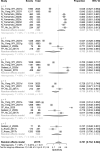Machine learning algorithms for diagnosis of hip bone osteoporosis: a systematic review and meta-analysis study
- PMID: 37430259
- PMCID: PMC10331995
- DOI: 10.1186/s12938-023-01132-9
Machine learning algorithms for diagnosis of hip bone osteoporosis: a systematic review and meta-analysis study
Abstract
Background: Osteoporosis is a significant health problem in the skeletal system, associated with bone tissue changes and its strength. Machine Learning (ML), on the other hand, has been accompanied by improvements in recent years and has been in the spotlight. This study is designed to investigate the Diagnostic Test Accuracy (DTA) of ML to detect osteoporosis through the hip dual-energy X-ray absorptiometry (DXA) images.
Methods: The ISI Web of Science, PubMed, Scopus, Cochrane Library, IEEE Xplore Digital Library, CINAHL, Science Direct, PROSPERO, and EMBASE were systematically searched until June 2023 for studies that tested the diagnostic precision of ML model-assisted for predicting an osteoporosis diagnosis.
Results: The pooled sensitivity of univariate analysis of seven studies was 0.844 (95% CI 0.791 to 0.885, I2 = 94% for 7 studies). The pooled specificity of univariate analysis was 0.781 (95% CI 0.732 to 0.824, I2 = 98% for 7 studies). The pooled diagnostic odds ratio (DOR) was 18.91 (95% CI 14.22 to 25.14, I2 = 93% for 7 studies). The pooled mean positive likelihood ratio (LR+) and the negative likelihood ratio (LR-) were 3.7 and 0.22, respectively. Also, the summary receiver operating characteristics (sROC) of the bivariate model has an AUC of 0.878.
Conclusion: Osteoporosis can be diagnosed by ML with acceptable accuracy, and hip fracture prediction was improved via training in an Architecture Learning Network (ALN).
Keywords: Artificial intelligence; Bone diseases; Hip; Lower extremity; Machine learning; Meta-analysis; Metabolic; Osteoporosis.
© 2023. The Author(s).
Conflict of interest statement
The authors declare that they have no competing interests.
Figures






Similar articles
-
Diagnostic test accuracy of machine learning algorithms for the detection intracranial hemorrhage: a systematic review and meta-analysis study.Biomed Eng Online. 2023 Dec 4;22(1):114. doi: 10.1186/s12938-023-01172-1. Biomed Eng Online. 2023. PMID: 38049809 Free PMC article.
-
Signs and symptoms to determine if a patient presenting in primary care or hospital outpatient settings has COVID-19.Cochrane Database Syst Rev. 2022 May 20;5(5):CD013665. doi: 10.1002/14651858.CD013665.pub3. Cochrane Database Syst Rev. 2022. PMID: 35593186 Free PMC article.
-
Prediction of prognosis in COVID-19 patients using machine learning: A systematic review and meta-analysis.Int J Med Inform. 2023 Sep;177:105151. doi: 10.1016/j.ijmedinf.2023.105151. Epub 2023 Jul 11. Int J Med Inform. 2023. PMID: 37473658
-
Health professionals' experience of teamwork education in acute hospital settings: a systematic review of qualitative literature.JBI Database System Rev Implement Rep. 2016 Apr;14(4):96-137. doi: 10.11124/JBISRIR-2016-1843. JBI Database System Rev Implement Rep. 2016. PMID: 27532314
-
Blood biomarkers for the non-invasive diagnosis of endometriosis.Cochrane Database Syst Rev. 2016 May 1;2016(5):CD012179. doi: 10.1002/14651858.CD012179. Cochrane Database Syst Rev. 2016. PMID: 27132058 Free PMC article.
Cited by
-
Exploring the Constituents and Mechanisms of Polygonum multiflorum Thunb. in Mitigating Ischemic Stroke: A Network Pharmacology and Molecular Docking Study.Comb Chem High Throughput Screen. 2025;28(5):781-797. doi: 10.2174/0113862073285988240229081558. Comb Chem High Throughput Screen. 2025. PMID: 38623977
-
Detection of Alzheimer Disease in Neuroimages Using Vision Transformers: Systematic Review and Meta-Analysis.J Med Internet Res. 2025 Feb 5;27:e62647. doi: 10.2196/62647. J Med Internet Res. 2025. PMID: 39908541 Free PMC article.
-
Application of Artificial Intelligence Methods on Osteoporosis Classification with Radiographs-A Systematic Review.Bioengineering (Basel). 2024 May 12;11(5):484. doi: 10.3390/bioengineering11050484. Bioengineering (Basel). 2024. PMID: 38790351 Free PMC article. Review.
-
Trends of Artificial Intelligence (AI) Use in Drug Targets, Discovery and Development: Current Status and Future Perspectives.Curr Drug Targets. 2025;26(4):221-242. doi: 10.2174/0113894501322734241008163304. Curr Drug Targets. 2025. PMID: 39473198 Review.
-
Diagnostic accuracy of chest X-ray and CT using artificial intelligence for osteoporosis: systematic review and meta-analysis.J Bone Miner Metab. 2024 Sep;42(5):483-491. doi: 10.1007/s00774-024-01532-4. Epub 2024 Aug 21. J Bone Miner Metab. 2024. PMID: 39167230
References
-
- Organization WH: WHO scientific group on the assessment of osteoporosis at primary health care level. In: Summary meeting report. 2004. Pp. 5–7.
Publication types
MeSH terms
LinkOut - more resources
Full Text Sources
Medical

